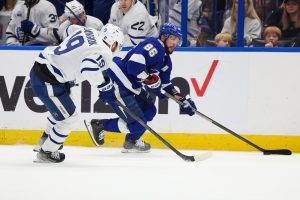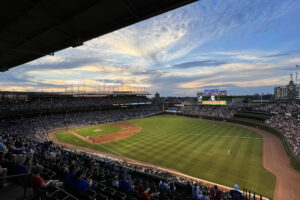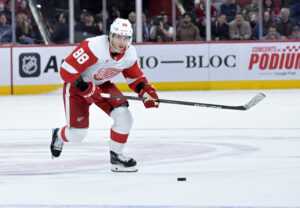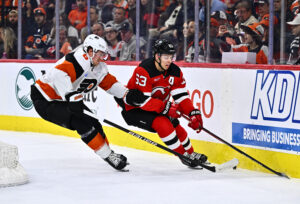One of the Vancouver Canucks fans’ long-time favourite targets has been the Canucks draft history.
Fans continuously point out the lackluster draft history the team holds. The complaint has been made for so long that it’s become a boilerplate criticism, one made without much thought. With so much unbridled criticism, it may be helpful to actually break down the team’s recent draft history.
How much of the alleged poor drafting history was from the people making the decisions and how much from the circumstances beyond their control? Scouting departments may not want to admit it but even now luck and straight-up guesswork play a large role in who makes it and who doesn’t – even players everyone feels have a 99 percent chance to succeed in their draft year might be in that one percent instead.
Breaking Down the Vancouver Canucks Draft History
The easiest thing to do would be to simply count whose players played the most NHL games. Teams who drafted players with higher numbers did better than those who didn’t, right? Sure but that doesn’t take into account what scouts were thinking at the time, which is what we’re trying to compare here. It also doesn’t take into account players who were scooped as a shot-in-the-dark who simply willed themselves into the league (like Canucks ninth round pick Jannik Hansen). This also penalizes scouts for teams who traded away high round positions – it’s tougher to get NHL players in later rounds than earlier ones, obviously enough.
Likewise, if you go by points alone, then a team that selected a couple of solid defencemen will look like they drafted worse than a team that managed one moderately good forward; and using games played as the sole basis would discount goaltenders entirely.
Method
So, here’s what the non-scientific method will be:
First let’s only count the first three rounds, which usually means every team has one shot at drafting players from later rounds but passed them by. Later players can succeed but if no one expects them to, then you can’t really blame a team for missing their shot. Tomas Holmstrom seems like an obvious pick now (a career with over 1000 games and 500 points to his credit) but he was taken 257th in his draft year. No one expected those numbers from him back in 1994. Crying because your team didn’t take him? Well, neither did 28 other teams, and they all had the chance!
Second, limiting which drafts are being counted to no later than 2009. This means teams that weren’t getting the ‘obvious’ players still had time to develop the ones they did choose without rushing anyone. Considering the 10-year gap since the 2009 NHL Draft, it’s safe to assume that most players who could have made the NHL would have by now.
Included below the Canucks selections will be that year’s averages-by-round. It will show how players, at each respective position and round, have faired since their name was called. This will be a great tool to show the strength of Vancouver’s picks that year.
The Canucks Draft History
2000
Canucks Picks
1st: Nathan Smith, F (26 Games Played, 0 Points)
2nd: No pick
3rd: Thatcher Bell, F (0 GP, 0 P); Tim Branham, D (0 GP, 0 P)
NHL average
1st: F (418 GP, 233 P); D (678 GP, 178 P); G (160 GP)
2nd: F (210 GP, 78 P); D (211 GP, 53 P); G (226 GP)
3rd: F (101 GP, 26 P); D (51 GP, 5 P); G (38 GP)
2001
Canucks Picks
1st: R. J. Umberger, F (779 GP, 392 P)
2nd: No pick
3rd: Fedor Fedorov, F (18 GP, 2 P)
NHL Average
1st: F (518 GP, 287 P); D (490 GP, 116 P); G (73 GP)
2nd: F (254 GP, 117 P); D (136 GP, 35 P); G (184 GP)
3rd: F (140 GP, 70 P); D (75 GP, 15 P); G (213 GP)
2002
Canucks Picks
1st: No pick
2nd: Kiril Koltsov, D (0 GP); Denis Grot, D (0 GP)
3rd: Brent Skinner, D (11 GP, 0 points); Lukas Mensator, G (0 GP)
NHL average
1st: F (468 GP, 221 P); D (477 GP, 178 P); G (470 GP)
2nd: F (204 GP, 92 P); D (337 GP, 116 P); G (49 GP)
3rd: F (196 GP, 87 P); D (27 GP, 1 P); G (4 GP)
2003
Canucks Picks
1st: Ryan Kesler, F (1,001 GP, 573 P)
2nd: Marc-Andre Bernier, F (0 GP, 0 P)
3rd: No pick
NHL average
1st: F (673 GP, 416 P); D (838 GP, 352 P); G (798 GP)
2nd: F (216 GP, 102 P); D (227 GP, 89 P); G (482 GP)
3rd: F (85 GP, 27 P); D (77 GP, 14 P); G (0 GP)
2004
Canucks Picks
1st: Cory Schneider, G (396 GP)
2nd: No pick
3rd: Alexander Edler, D (814 GP, 368 P)
NHL average
1st: F (485 GP, 323 P); D (354 GP, 113 P); G (265 GP)
2nd: F (201 GP, 99 P); D (140 GP, 46 P); G (42 GP)
3rd: F (106 GP, 39 P); D (230 GP, 70 P); G (69 GP)
2005
Canucks Picks
1st: Luc Bourdon, D (36 GP, 2 P)
2nd: Mason Raymond, F (546 GP, 251 P)
3rd: No pick
[Bourdon died at age 21]
NHL average
1st: F (448 GP, 288 P); D (308 GP, 85 P); G (560 GP)
2nd: F (221 GP, 112 P); D (167 GP, 43 P); G (100 GP)
3rd: F (18 GP, 4 P); D (211 GP, 83 P); G (324 GP)
2006
Canucks Picks
1st: Michael Grabner, F (594 GP, 265 P)
2nd: No pick
3rd: Daniel Rahimi, F (0 GP, 0 P)
NHL average
1st: F (718 GP, 440 P); D (100 GP, 35 P); G (197 GP)
2nd: F (211 GP, 86 P); D (109 GP, 31 P); G (205 GP)
3rd: F (118 GP, 50 P); D (72 GP, 10 P); G (175 GP)
2007
Canucks Picks
1st: Patrick White, F (0 GP, 0 P)
2nd: Taylor Ellington, D (0 GP, 0 P)
3rd: No pick
NHL average
1st: F (460 GP, 282 P); D (325 GP, 103 P); G (N/A)
2nd: F (133 GP, 51 P); D (66 GP, 39 P); G (3 GP)
3rd: F (64 GP, 25 P); D (161 GP, 29 P); G (1 GP)
2008
Canucks Picks
1st: Cody Hodgson, F (328 GP, 142 P)
2nd: Yann Sauve, D (8 GP, 0 P)
3rd: No pick
NHL average
1st: F (320 GP, 182 P); D (549 GP, 250 P); G (2 GP)
2nd: F (96 GP, 45 P); D (218 GP, 80 P); G (124 GP)
3rd: F (122 GP, 44 P); D (56 GP, 13 P); G (37 GP)
2009
Canucks Picks
1st: Jordan Schroeder, F (165 GP, 42 P)
2nd: Anton Rodin, F (3 GP, 1 P)
3rd: Kevin Connauton, D (310 GP, 76 P)
NHL average
1st: F (376 GP, 211 P); D (398 GP, 147 P); G (N/A)
2nd: F (220 GP, 94 P); D (97 GP, 28 P); G (162 GP)
3rd: F (107 GP, 41 P); D (136 GP, 52 P); G (33 GP)
An Imperfect Comparison
While these numbers certainly aren’t perfect, skewed by a variety of factors, showing them in their rawest form helps to exemplify the risk that comes with drafting players. With the top-three rounds boasting the players with the greatest likelihood to make the NHL, there’s no arguing that the Canucks had a hardy amount of faith in every player selected. Yet, the team is in the red more-often-than-not.
These averages don’t dive into how well specific teams train their prospects into NHL-caliber players. This is an entirely different monster, with its own respective stats and debates. Yet, looking at the best, and the worst, of times, may give some insight to this enigmatic issue.
Worst of Times
The 2007 draft looks particularly awful. The Canucks surprised the league by selecting Patrick White 25th overall. White was ranked 23rd among North-American skaters, by the Central Scouting Services, headed into the 2007 NHL Draft. He was selected over many stars, including P.K. Subban, who was picked by the Montreal Canadiens 18 picks later. The St. Louis Blues grabbed their own star with the very next pick. With the 26th overall pick, they selected David Perron. Perron has developed into a prominent top-six winger in the NHL over the course of his 12-year career.
It could be argued that 2002 was a worse draft for Vancouver, though. They did not possess a first-round pick that year, instead, holding two picks in each of the second and third rounds. Yet, out of the four players they selected in the latter two rounds, only one managed to play in NHL games. Even worse, he only played in 11 NHL games. Sure, that’s more than they managed from the 2007 group but there was talent available in those rounds in 2002 that the team simply missed.
Best of Times
There’s a clear winner here: the Canucks drafted well beyond expectations in 2004. Cory Schneider, who has played just under 400 NHL games, was taken 26th overall. They also drafted Edler in the third-round, an absolute steal in hindsight. He is clearly fighting it out with Mike Green, Mark Streit, and Alex Goligoski for best defenceman in the draft.
On a personal note, the 2004 NHL Draft produced one of my all-time favourite Canucks in the aforementioned Jannik Hansen may also be colouring this opinion.
Looking Forward
Collecting these numbers is more a means to settle bets than it is to formulate a plan for future drafting but there are pieces of information to be mined in a more general sense. At first glance, what stands out is how few picks the Canucks had in this decade. They had nine picks in the first round, seven in the second, and eight in the third round.
That’s a fairly lackluster total and not ideal for a team that struggled to make the playoffs prior to 2001. The Canucks mostly moved picks out in an effort to find goaltenders. Dan Cloutier, Alex Auld, Johan Hedberg, and Maxime Oulette all spent time with the team and all were acquired for picks in the first five years of the decade. Vancouver finally struck gold when they acquired Roberto Luongo from the Florida Panthers in 2006. The Canucks drafted seven goalies between 2000 and 2009 but only one (Schneider) managed a successful NHL career. The continued failure of goalie prospects since the turn of the century has clearly taught the Canucks a lesson, as, since 2010, they have drafted two top-end goalie prospects.
It’s clear that they learned their lesson. The two “goalies of the future” in the system – Thatcher Demko, currently the team’s backup, and Michael DiPietro, entering his first pro season, are widely viewed as can’t-miss prospects, and were taken 36th and 64th in their respective draft years.
What it Means
Looking at the numbers this way, the Canucks draft history between 2000 and 2009 was undoubtedly poor.
They were clearly below-average with their selections, with a surprising amount of players never playing in the NHL. While every team has its fair share of prospects that don’t pan out, there’s a certain gut-punch that comes with the Canucks draft history. Yet, there are plenty of hypotheticals. The team is clearly kicking themselves for not taking Subban in the 2007 NHL Draft but there were plenty of busts prior to their selection as well. In fact, five of the first-round picks from that year never made it to the NHL at all, including Vancouver’s pick. Two more players only saw 20-games-or-less.
It’s fun to play “What If…?” years after the drafts have happened. Hindsight 20/20 has become a clear slogan among scouts who passed up late-round steals such as Pekka Rinne, who fell to the 258th overall pick in 2004. While the Canucks have had a disappointing draft career in recent years, the criticism may be a little much, with genuine bad luck playing a big role.
 OTTAWA, ON – JANUARY 02: Vancouver Canucks Defenceman Alexander Edler (23) skates the puck around the net during second period National Hockey League action between the Vancouver Canucks and Ottawa Senators on January 2, 2019, at Canadian Tire Centre in Ottawa, ON, Canada. (Photo by Richard A. Whittaker/Icon Sportswire via Getty Images)
OTTAWA, ON – JANUARY 02: Vancouver Canucks Defenceman Alexander Edler (23) skates the puck around the net during second period National Hockey League action between the Vancouver Canucks and Ottawa Senators on January 2, 2019, at Canadian Tire Centre in Ottawa, ON, Canada. (Photo by Richard A. Whittaker/Icon Sportswire via Getty Images)





